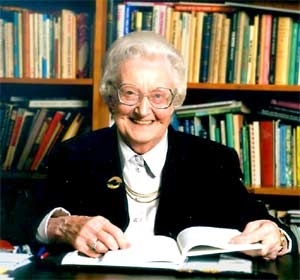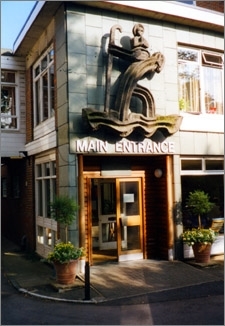 |
| Dame Cicely Saunders |
Dame Cicely Saunders (June 22, 1918–July 14, 2005) founded the modern hospice and started a worldwide movement to provide compassionate care for the dying. A nurse, social worker and doctor, she established new methods of pain control and a multi-faceted, holistic approach to care giving. This led to the development of a new medical specialty, palliative care, and the contemporary hospice.
"We have to concern ourselves with the quality of life as well as its length," Dame Cicely, as she was known affectionately in England, declared. This pioneering woman opened the first modern hospice in a residential suburb of London in 1967. Today, St. Christopher's Hospice welcomes around 4,000 visitors annually and more than 50,000 health care professionals from all over the world visit and train there.
In the Beginning
Saunders was from a well-to-do family, but her parents' marriage was an unhappy one and her mother was cold and uncaring. Not one to feel sorry for herself, Saunders started her university education in Oxford in 1938, but when World War II broke out, she took up nursing. In 1945 her parents divorced and she converted from agnosticism to evangelical Christianity. “I prayed to know how best to serve God,” she said. The answer came soon enough. "My story in this field goes right back to 1948 when I was a social worker… meeting a young Polish Jew who had an inoperable cancer," Saunders says. "I became very fond of him." David Tasma had escaped the Warsaw ghetto and was dying in a London hospital.
 |
| St. Christopher's Hospice |
“A Window In Your Home”
Tasma’s pain, loneliness and anguish had a profound affect on Saunders. She visited Tasma frequently in the last two months of his life. As Saunders and Tasma spoke of his looming death, Saunders had a revelation: “I realized that we needed not only better pain control but better overall care. People needed the space to be themselves. I coined the term ‘total pain,’ from my understanding that dying people have physical, spiritual, psychological, and social pain that must be treated. I have been working on that ever since.”
At his death, Tasma bequeathed her 500 pounds and said he’d “be a window in your home.” As a result of their conversations and his gift of love, Saunders discovered her mission: to ease all kinds of end-of-life pain. In a 2002 interview for The Daily Telegraph of London, she said, “I didn't set out to change the world; I set out to do something about pain." Saunders’ work was a “personal calling, underpinned by a powerful religious commitment,” wrote David Clark, an English medical school professor of palliative care and Saunders’ biographer.
Doctor for the Dying
Compelled by her mission, she volunteered at St. Joseph's Hospice in London. Because the patients were perceived as beyond help, the nuns didn’t stick to pain control guidelines. Saunders learned to administer morphine before pain appeared, thus staying ahead of the pain. This would later influence her ideas about pain management and treatment. Saunders conceived of giving patients a regular pain control schedule, which, in her words, “was like waving a wand over the situation.”
Her surgeon friend advised Saunders that if she were dedicated to pain management and caring for the terminally ill, people wouldn’t listen to a nurse. So, at the age of 33, at a time when there were few women doctors, she studied to be a physician. When she earned her medical degree in 1957 she became the first modern doctor to devote her career to dying patients. While still working at St. Joseph’s, she met the second Pole in her life, 60-year old Antoni Michniewicz. He inspired her to name her own hospice for people in the final stage of life’s journey. He suggested she name it after the patron saint of travelers, St. Christopher. It would take her another ten years to open St. Christopher’s Hospice, the world's first modern hospice. And she’d spend more than 50 years trying to humanize the dying experience for patients and their families.
St. Christopher’s Hospice
In 1967, St. Christopher's Hospice in London opened and sparked the modern hospice movement. Tasma’s “window,” is remembered with a plain sheet of glass in the hospice’s entrance. Clearly, Saunders had strong Christian convictions and felt a divine calling, but her hospice was a haven for people of all persuasions. Saunders proved to be an outstanding planner, medical administrator, energetic fund-raiser and publicist as well as a passionate visionary. She believed that “to face death is to face life and to come to terms with one is to learn much about the other.” Combining clinical care with teaching and research, here was a true home and sanctuary. Patients could be treated medically, as well as garden, write, get their hair styled, and take art classes.
After happening on some beautiful art herself, Saunders fell in love with yet another Polish man, artist Marian Bohusz-Szyszko. They married when she was 61 and he was 79 and in poor health. She covered the walls of St Christopher's, where he came to live and paint, with his pictures. He died at St. Christopher’s.
 |
The Spread of the Hospice Movement
In the 60s, Saunders’ many travels to New York, Los Angeles and Boston set the groundwork for the spread of hospices. After speaking at Yale—once with Elisabeth Kubler-Ross--Saunders inspired Florence Wald in Connecticut, who is credited with founding the US hospice movement in 1971.
Even when she was just a member of the audience, Dame Cicely was a beacon for others. “I sat next to her at a lecture in the late 70s,” said Ann Armstrong Dailey, founder of Children’s Hospice International. “She was really stately and had such a towering presence.” Dailey added, “Her spirit is large and her heart is large. She broke all kinds of ground for this movement. We’re all grateful to her.”
At a time when many embraced euthanasia, Dame Cicely Saunders had a different viewpoint. Her vision “led to a model that has changed the face of dying across the world,” according to the Pioneers of Hospice. There are currently 3,200 hospices serving 900,000 patents in the US alone and 8,000 hospices in 100 countries around the world.
Her Legacy
Fittingly, Dame Cicely died at St. Christopher’s Hospice in 2005, at age 87. The New York Times said she “reshaped end-of-life care.” In a deeper sense, Saunders transformed how we care for those with terminal illnesses as well as the bleak way we look at dying.
One of her legacies is the change in pain management. Saunders’ questioned practitioners’ fear that their dying patients would become addicted to medications. Rather than respond to pain with intermittent sedation, Saunders’ novel method of pain control provided a steady state in which a dying patient could remain conscious and maintain a good quality of life.
Moving beyond physical pain, one of her lasting contributions to health care was her concept of “total pain.” This included physical, emotional, social, and spiritual elements. She focused on caring for the whole person and enfolding their family and friends within that care. This led to the development of a new medical specialty, palliative care, and modern hospice philosophy.
Cicely Saunders lectured widely, published articles, edited and wrote books and launched the Cicely Saunders Foundation to promote research into palliative care. The formidable leader was made a Dame Commander of the British Empire, awarded the Templeton Prize (the world's richest annual prize awarded to an individual) and given the prestigious Order of Merit by Queen Elizabeth II. In 2001, St. Christopher’s Hospice garnered the Conrad N. Hilton Humanitarian Prize, the world’s largest humanitarian award and the organization honored Dame Cicely. In 2005, the National Portrait Gallery unveiled another portrait of her.
Dame Cicely Saunders was an Englishwoman who had a huge impact on our world. Yet, her philosophy was simple. As she said to patients, “You matter because you are you, and you matter to the last moment of your life.”
Page created on 9/29/2012 8:36:57 PM
Last edited 1/9/2017 9:41:15 PM
